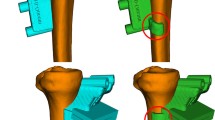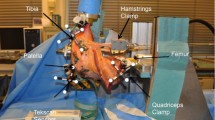Abstract
Purpose
Intraoperative fracture of the lateral cortex fractures of the tibia is a potential complication of high tibial osteotomy (HTO), which may result in inadequate rotational alignment of the distal tibia. Our aim was to determine how rotational malalignment of the distal tibial segment distal would affect intraarticular contact pressure distribution in the knee and ankle joints.
Methods
A medial, L-shaped opening-wedge HTO was performed on seven human lower body specimens. A stainless steel device with integrated load cell was used to axially load the leg. Pressure-sensitive sensors were used to measure intraarticular contact pressures. Intraoperative changes in alignment were monitored in real time using computer navigation. Measurements were performed in the native knee alignment, after 10° and 15° of alignment correction and with the distal tibia fixed at 15° of external rotation.
Results
Moderate-to-large alignment changes after medial opening-wedge HTO resulted in a shift in intraarticular contact pressures from the medial compartment of the knee towards the lateral compartment. However, fixation of the distal tibial segment at 15° of external rotation neutralized this intended beneficial effect. In the ankle, external rotation of the distal tibia also caused a reduction in contact pressures and tibiotalar contact area.
Conclusion
Malrotation of the distal tibial fragment negates the intended effect of offloading the diseased compartment of the knee, with the contact pressures remaining similar to those of the native knee. Furthermore, malrotation leads to abnormal ankle contact pressures. Care should be taken to ensure appropriate rotational alignment of the distal tibial segment during intraoperative fixation of HTO procedures.





Similar content being viewed by others
References
Agneskirchner JD, Hurschler C, Stukenborg-Colsman C, Imhoff AB, Lobenhoffer P (2004) Effect of high tibial flexion osteotomy on cartilage pressure and joint kinematics: a biomechanical study in human cadaveric knees. Winner of the AGA-DonJoy Award 2004. Arch Orthop Trauma Surg 124(9):575–584
Agneskirchner JD, Hurschler C, Wrann CD, Lobenhoffer P (2007) The effects of valgus medial opening wedge high tibial osteotomy on articular cartilage pressure of the knee: a biomechanical study. Arthroscopy 23(8):852–861
Akamatsu Y, Mitsugi N, Mochida Y, Taki N, Kobayashi H, Takeuchi R, Saito T (2012) Navigated opening wedge high tibial osteotomy improves intraoperative correction angle compared with conventional method. Knee Surg Sports Traumatol Arthrosc 20(3):586–593
Amis AA (2013) Biomechanics of high tibial osteotomy. Knee Surg Sports Traumatol Arthrosc 21(1):197–205
Fening SD, Kovacic J, Kambic H, McLean S, Scott J, Miniaci A (2008) The effects of modified posterior tibial slope on anterior cruciate ligament strain and knee kinematics: a human cadaveric study. J Knee Surg 21(3):205–211
Floerkemeier S, Staubli AE, Schroeter S, Goldhahn S, Lobenhoffer P (2013) Outcome after high tibial open-wedge osteotomy: a retrospective evaluation of 533 patients. Knee Surg Sports Traumatol Arthrosc 21(1):170–180
Giffin JR, Stabile KJ, Zantop T, Vogrin TM, Woo SL, Harner CD (2007) Importance of tibial slope for stability of the posterior cruciate ligament deficient knee. Am J Sports Med 35(9):1443–1449
Giffin JR, Vogrin TM, Zantop T, Woo SL, Harner CD (2004) Effects of increasing tibial slope on the biomechanics of the knee. Am J Sports Med 32(2):376–382
Han SB, Lee DH, Shetty GM, Chae DJ, Song JG, Nha KW (2013) A “safe zone” in medial open-wedge high tibia osteotomy to prevent lateral cortex fracture. Knee Surg Sports Traumatol Arthrosc 21(1):90–95
Javidan P, Adamson GJ, Miller JR, Durand P Jr, Dawson PA, Pink MM, Lee TQ (2013) The effect of medial opening wedge proximal tibial osteotomy on patellofemoral contact. Am J Sports Med 41(1):80–86
Kendoff D, Board TN, Citak M, Gardner MJ, Hankemeier S, Ostermeier S, Krettek C, Hufner T (2008) Navigated lower limb axis measurements: influence of mechanical weight-bearing simulation. J Orthop Res 26(4):553–561
Liodakis E, Kenawey M, Liodaki E, Mommsen P, Krettek C, Hankemeier S (2010) The axis-board: an alternative to the cable technique for intraoperative assessment of lower limb alignment. Technol Health Care 18(3):165–171
Lobenhoffer P, Agneskirchner J, Zoch W (2004) Open valgus alignment osteotomy of the proximal tibia with fixation by medial plate fixator. Der Orthopade 33(2):153–160
Lobenhoffer P, Agneskirchner JD (2003) Improvements in surgical technique of valgus high tibial osteotomy. Knee Surg Sports Traumatol Arthrosc 11(3):132–138
Martin R, Birmingham TB, Willits K, Litchfield R, Lebel ME, Giffin JR (2014) Adverse event rates and classifications in medial opening wedge high tibial osteotomy. Am J Sports Med 42(5):1118–1126
McKellop HA, Sigholm G, Redfern FC, Doyle B, Sarmiento A, Luck JV Sr (1991) The effect of simulated fracture-angulations of the tibia on cartilage pressures in the knee joint. J Bone Joint Surg Am 73(9):1382–1391
Miller BS, Downie B, McDonough EB, Wojtys EM (2009) Complications after medial opening wedge high tibial osteotomy. Arthroscopy 25(6):639–646
Mina C, Garrett WE Jr, Pietrobon R, Glisson R, Higgins L (2008) High tibial osteotomy for unloading osteochondral defects in the medial compartment of the knee. Am J Sports Med 36(5):949–955
Pape D, Duchow J, Rupp S, Seil R, Kohn D (2006) Partial release of the superficial medial collateral ligament for open-wedge high tibial osteotomy. A human cadaver study evaluating medial joint opening by stress radiography. Knee Surg Sports Traumatol Arthrosc 14(2):141–148
Pape D, Kohn D, van Giffen N, Hoffmann A, Seil R, Lorbach O (2013) Differences in fixation stability between spacer plate and plate fixator following high tibial osteotomy. Knee Surg Sports Traumatol Arthrosc 21(1):82–89
Rodner CM, Adams DJ, Diaz-Doran V, Tate JP, Santangelo SA, Mazzocca AD, Arciero RA (2006) Medial opening wedge tibial osteotomy and the sagittal plane: the effect of increasing tibial slope on tibiofemoral contact pressure. Am J Sports Med 34(9):1431–1441
Stoffel K, Willers C, Korshid O, Kuster M (2007) Patellofemoral contact pressure following high tibial osteotomy: a cadaveric study. Knee Surg Sports Traumatol Arthrosc 15(9):1094–1100
Suero EM, Sabbagh Y, Westphal R, Hawi N, Citak M, Wahl FM, Krettek C, Liodakis E (2014) Effect of medial opening wedge high tibial osteotomy on intraarticular knee and ankle contact pressures. J Orthop Res. doi:10.1002/jor.22793
Takeuchi R, Ishikawa H, Kumagai K, Yamaguchi Y, Chiba N, Akamatsu Y, Saito T (2012) Fractures around the lateral cortical hinge after a medial opening-wedge high tibial osteotomy: a new classification of lateral hinge fracture. Arthroscopy 28(1):85–94
Tarr RR, Resnick CT, Wagner KS, Sarmiento A (1985) Changes in tibiotalar joint contact areas following experimentally induced tibial angular deformities. Clin Orthop Relat Res 199:72–80
van Raaij TM, Brouwer RW, de Vlieger R, Reijman M, Verhaar JA (2008) Opposite cortical fracture in high tibial osteotomy: lateral closing compared to the medial opening-wedge technique. Acta Orthop 79(4):508–514
Voos JE, Suero EM, Citak M, Petrigliano FP, Bosscher MR, Wickiewicz TL, Pearle AD (2012) Effect of tibial slope on the stability of the anterior cruciate ligament-deficient knee. Knee Surg Sports Traumatol Arthrosc 20(8):1626–1631
Yazdi H, Mallakzadeh M, Sadat Farshidfar S, Givehchian B, Daneshparvar H, Behensky H (2014) The effect of tibial rotation on knee medial and lateral compartment contact pressure. Knee Surg Sports Traumatol Arthrosc. doi:10.1007/s00167-014-3321-x
Acknowledgments
None of the authors have any professional or financial affiliations that could have biased this study. Funding awarded by the German Research Foundation (DFG) was used to construct the device used for axially loading the limb and the computer interface used to monitor changes in the knee joint during the experiments. Funding awarded by the Robert Mathys Foundation (RMS) was used for all materials required for performing the surgeries and for performing ankle measurements.
Author information
Authors and Affiliations
Corresponding author
Additional information
Eduardo M. Suero and Nael Hawi have contributed equally to this work.
Rights and permissions
About this article
Cite this article
Suero, E.M., Hawi, N., Westphal, R. et al. The effect of distal tibial rotation during high tibial osteotomy on the contact pressures in the knee and ankle joints. Knee Surg Sports Traumatol Arthrosc 25, 299–305 (2017). https://doi.org/10.1007/s00167-015-3553-4
Received:
Accepted:
Published:
Issue Date:
DOI: https://doi.org/10.1007/s00167-015-3553-4




